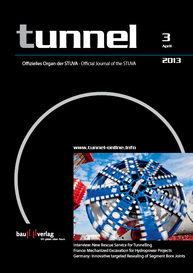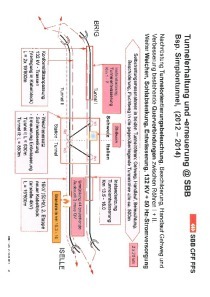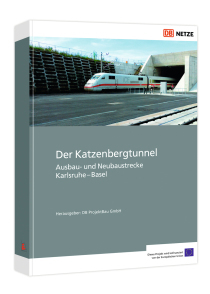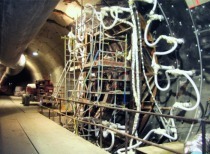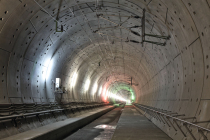Katzenberg Tunnel operational
The 8,385 m long Katzenberg Tunnel was opened after 9 years of construction when the timetable changed on December 9, 2012. A few days previously 2 trains, an ICE and a goods train, passed parallel to each other through the 2 tunnel bores set 26 m apart. Both bores were driven with overburden ranging from 25 to 120 m over 8,984 m by trenchless means with two 286 and 115 m long cut-and-cover sections. The project includes 18 cross-passages produced by mining means at intervals of 500 m (with 12 m long lock chambers and automatic doors) and two 74 m deep ventilation shafts.
Two EPB shields (12.11 m diameter, S-264 and S-265, Herrenknecht AG) were applied and the 60 cm thick segmental lining was accomplished at a water pressure of up to 9.2 bar. The installed solid slab track (FF) can be used by vehicles belonging to the emergency services and is made of prefabricated parts constituting track supporting layers with continuous coupling forming a permanent superstructure. All tunnel portals possess protective hooded structures to avoid the sonic boom effect [2, 3], namely at the north portal with pressure relief ports to the surface and at the south portal with lateral ventilation slots. The multi-stage safety concept applying to tunnels corresponding to the guidelines for fire and catastrophe protection has been implemented in exemplary fashion for the Katzenberg Tunnel in engineering terms (2 bores connected with cross-passages, lateral escape and evacuation routes, safety lighting), evacuation points at the portals (also suitable as helicopter pads), hooded protective structures at the portals to avoid the sonic boom effect and roof-shaped longitudinal profile (emergency brake override) [4].
The Katzenberg Tunnel represents an essential part of the new and upgraded Karlsruhe-Basle route (250 km/h). € 610 million was invested in this tunnel and its link to the Rheintalbahn railway (totalling 17.6 km); the roughwork for the 2 single-track tunnels alone cost € 340 million.
The 182 km long new and upgraded Karlsruhe-Basle route forms the core of the freight train corridor between Rotterdam and Genoa and is being developed for 4-tracks for € 5.7 billion in order to create additional capacities for goods traffic as well as passenger trains. The section between Rastatt and Offenburg is already operational; construction is currently forging ahead to the south of the Katzenberg Tunnel in the direction of Basle. The prior conditions were created in October 2012 with an agreement between the state and the Deutsche Bahn governing the financing to be able to tackle the 16 km long northern project section with the 4,277 m long Rastatt Tunnel [5] as from next year. G.B.

